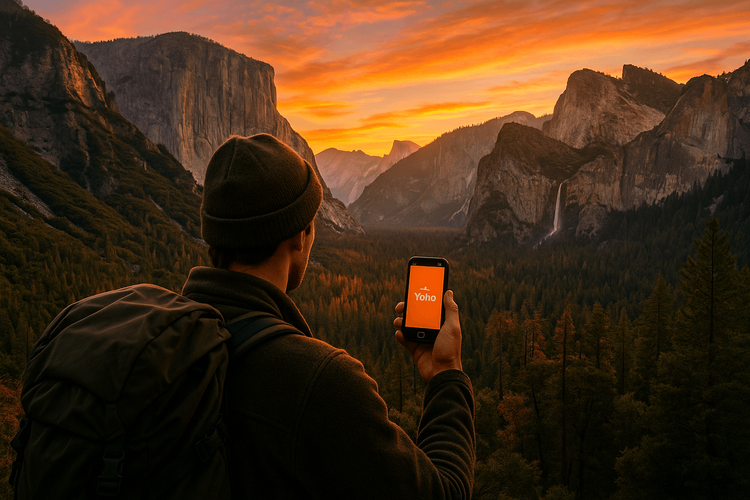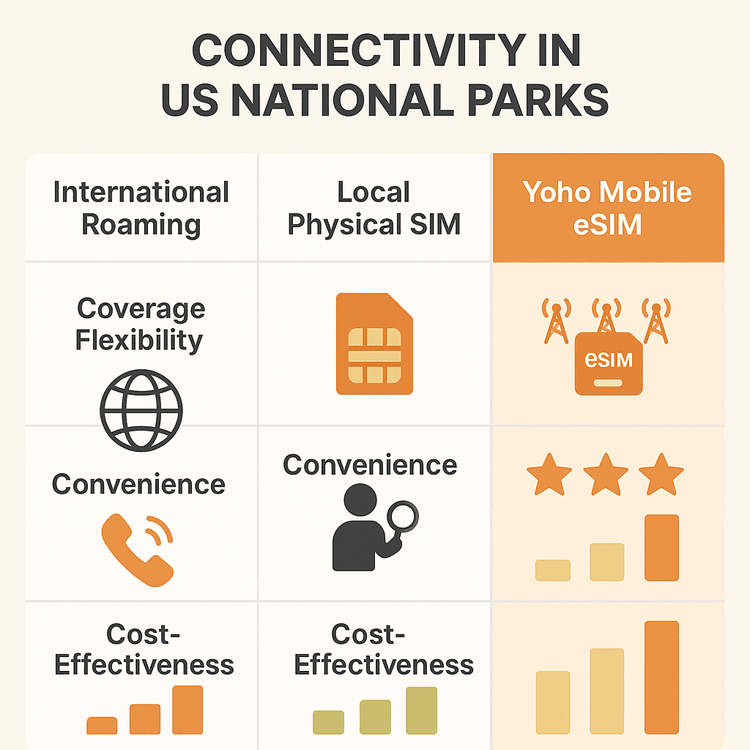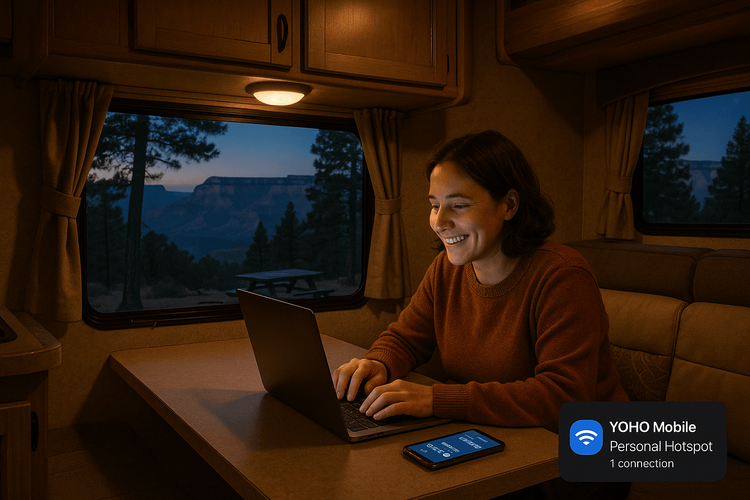Połączenie z siecią w dziczy: Realistyczny przewodnik po zasięgu komórkowym w parkach narodowych USA (2025)
Bruce Li•Sep 16, 2025
Podczas każdej przygody w parku narodowym jest taki moment – stojąc na krawędzi Wielkiego Kanionu, obserwując erupcję gejzeru Old Faithful czy wpatrując się w granitowe klify Yosemite – kiedy czujesz się całkowicie odłączony od świata, i jest to zapierające dech w piersiach. Ale jest też ten drugi moment: kiedy faktycznie potrzebujesz być połączonym i zdajesz sobie sprawę, że nie masz ani jednej kreski zasięgu. Cyfrowy detoks jest wspaniały, dopóki nie musisz sprawdzić pogody, pobrać mapy szlaku czy poinformować rodziny, że jesteś bezpieczny.
Poruszanie się po rozległych, pięknych i często odległych krajobrazach amerykańskich parków narodowych wymaga innego podejścia do łączności. Chociaż nie ma magicznego rozwiązania na idealny zasięg, strategiczne planowanie z nowoczesnymi narzędziami, takimi jak eSIM, może zmienić Twoje doświadczenie z frustracji w poczucie wolności. Planujesz epicką podróż po USA? Najpierw zadbajmy o Twoją łączność dzięki planowi eSIM Yoho Mobile na USA.

Wielkie rozłączenie: Dlaczego zasięg komórkowy w parkach narodowych jest tak słaby?
Słaby zasięg w parkach narodowych nie jest przypadkiem; to wynik celowej ochrony i trudnej geografii. Główną misją Służby Parków Narodowych (NPS) jest zachowanie tych dzikich przestrzeni w ich naturalnym stanie. Oznacza to:
- Ograniczona infrastruktura: Budowa wież komórkowych jest mocno ograniczona, aby nie zakłócać krajobrazu i życia dzikich zwierząt. Nie znajdziesz wież na każdym malowniczym punkcie widokowym.
- Trudny teren: Cechy, które czynią te parki zachwycającymi – głębokie kaniony, wysokie góry i gęste lasy – niezwykle skutecznie blokują sygnały komórkowe.
- Ogromna powierzchnia: Wiele parków zajmuje tysiące mil kwadratowych z bardzo małą liczbą ludzi, co sprawia, że zapewnienie kompleksowego zasięgu jest dla operatorów komercyjnie nieopłacalne.
Zrozumienie tego pomaga ustalić kluczowe oczekiwanie: w parku narodowym zasięg jest szczęśliwym bonusem, a nie gwarancją.
W poszukiwaniu sygnału: Realistyczne spojrzenie na główne parki
Na podstawie raportów z forów dla kamperowiczów, turystów pieszych i podróżników, zasięg komórkowy zazwyczaj występuje w małych, skoncentrowanych obszarach, zwykle w najbardziej rozwiniętych częściach. Oto, czego realistycznie możesz się spodziewać w niektórych z najpopularniejszych parków:
Park Narodowy Yellowstone
Łączność w Yellowstone jest notorycznie słaba. Największe szanse masz w pobliżu głównych ośrodków turystycznych.
- Prawdopodobne miejsca: Centrum dla zwiedzających Old Faithful, Canyon Village, Mammoth Hot Springs i Grant Village.
- Rzeczywistość: Nawet w tych miejscach sygnał może być przeciążony i wolny, zwłaszcza w szczycie sezonu. Nie spodziewaj się streamowania wideo. Verizon i AT&T są często wymieniani jako operatorzy z najbardziej funkcjonalnym, choć ograniczonym, zasięgiem. To doskonały przykład, gdzie wiedza o tym, jaki jest najlepszy operator komórkowy w Parku Narodowym Yellowstone, polega mniej na znalezieniu idealnego, a bardziej na posiadaniu opcji.
Park Narodowy Yosemite
Zasięg tutaj jest niemal całkowicie ograniczony do jednego obszaru.
- Prawdopodobne miejsca: Dolina Yosemite, szczególnie w okolicach Centrum dla zwiedzających, Yosemite Village i hotelu The Ahwahnee.
- Rzeczywistość: Gdy tylko wjedziesz na drogę Tioga Road lub udasz się w głąb parku w kierunku Tuolumne Meadows, możesz spodziewać się całkowitego zaniku zasięgu. Jeśli zastanawiasz się, jak uzyskać zasięg komórkowy w Yosemite, odpowiedź brzmi: trzymaj się dna doliny lub, co lepsze, przygotuj się do działania w trybie offline.
Park Narodowy Zion
Wysokie ściany kanionu Zion są naturalnym blokerem sygnału.
- Prawdopodobne miejsca: Centrum dla zwiedzających Zion Canyon i przyległe miasteczko Springdale. Możesz złapać słaby, użyteczny sygnał na niektórych odcinkach szlaku Pa’rus Trail.
- Rzeczywistość: Gdy tylko zagłębisz się w główny kanion, aby wędrować szlakami The Narrows lub Angels Landing, będziesz całkowicie poza siecią.

Rozwiązanie dla sprytnego podróżnika: Dlaczego eSIM jest Twoim najlepszym sojusznikiem
Jeśli nie możesz polegać na jednym operatorze, jakie jest rozwiązanie? Potrzebujesz technologii, która daje Ci opcje. To właśnie tutaj użycie eSIM podczas podróży samochodem po USA staje się przełomem i kluczowym elementem Twojego zestawu technologii do podróży na świeżym powietrzu.
Zaleta wielu operatorów
Jednym z największych ograniczeń tradycyjnej karty SIM jest przywiązanie do jednej sieci. Jeśli ta sieć nie ma w okolicy wież, masz pecha. Karty eSIM Yoho Mobile działają inaczej. Mogą łączyć się z wieloma lokalnymi sieciami operatorów (takimi jak AT&T i T-Mobile). Oznacza to, że Twój telefon automatycznie wyszukuje i łączy się z najsilniejszym dostępnym sygnałem w Twojej okolicy, radykalnie zwiększając Twoje szanse na znalezienie zasięgu w tych marginalnych obszarach, gdzie jeden operator może mieć słaby sygnał, a inny żadnego.
Nie ryzykuj, stawiając na jedną sieć. Odkryj elastyczne plany Yoho Mobile na USA i zmaksymalizuj swoje możliwości zasięgu.
Bezproblemowa konfiguracja i elastyczność
Zapomnij o szukaniu sklepu z fizycznymi kartami SIM w małym miasteczku. Z eSIM możesz wszystko skonfigurować w kilka minut. Dla użytkowników iOS jest to jeszcze prostsze: po zakupie wystarczy dotknąć przycisku „Zainstaluj”, aby rozpocząć płynny, jednominutowy proces instalacji – bez potrzeby skanowania kodów QR. Zanim wyruszysz, upewnij się, że Twoje urządzenie jest gotowe na przygodę, sprawdzając naszą listę urządzeń kompatybilnych z eSIM.
Siatka bezpieczeństwa Yoho Care
Wyobraź sobie, że kończy Ci się szybki internet akurat wtedy, gdy znajdujesz zasięg i desperacko potrzebujesz pobrać mapę offline. Z Yoho Mobile to nie jest katastrofa. Nawet jeśli Twój główny pakiet danych zostanie zużyty, nasza usługa Yoho Care zapewnia, że nigdy nie zostaniesz całkowicie odcięty, oferując podstawowe połączenie do niezbędnych potrzeb, takich jak wiadomości i wyszukiwanie nawigacji.
Poza eSIM: Niezbędne wskazówki dotyczące łączności w dziczy
Twój eSIM to najlepsze narzędzie, ale przygotowany podróżnik ma wiele strategii. Oto kilka niezbędnych wskazówek, jak pozostać w kontakcie podczas podróży samochodem po USA przez parki:
- Pobierz wszystko z wyprzedzeniem: To złota zasada. Pobierz mapy offline w Google Maps lub dedykowanych aplikacjach, takich jak AllTrails. Zapisz w telefonie swoje bilety wstępu do parku, potwierdzenia rezerwacji i przewodniki.
- Korzystaj z Wi-Fi w centrach dla zwiedzających: Większość głównych centrów dla zwiedzających i niektóre schroniska w parkach oferują bezpłatne publiczne Wi-Fi. Może być wolne, ale jest idealne do pobrania informacji na ostatnią chwilę lub wysłania krótkiej wiadomości „Wszystko w porządku!”.
- Poinformuj kogoś o swoich planach: Zawsze informuj przyjaciela lub członka rodziny o swoim szczegółowym planie podróży, w tym o planowanych szlakach i przewidywanych godzinach powrotu.
- Rozważ komunikator satelitarny: Dla poważnych turystów pieszych lub tych, którzy zapuszczają się w głąb dziczy, urządzenia takie jak Garmin inReach są ostateczną siatką bezpieczeństwa. Jak zauważają publikacje takie jak OutdoorGearLab, oferują one funkcje komunikacji i SOS całkowicie niezależne od sieci komórkowych.

Często zadawane pytania (FAQ)
Który operator komórkowy ma najlepszy zasięg w parkach narodowych USA?
Żaden pojedynczy operator nie jest „najlepszy” wszędzie. Zasięg jest bardzo zmienny i specyficzny dla danego parku. Historycznie Verizon miał niewielką przewagę ze względu na inwestycje w sieci wiejskie, ale AT&T i T-Mobile również mają silne punkty zasięgu. Dlatego eSIM obsługujący wielu operatorów, który może przełączać się między sieciami, jest strategią lepszą niż poleganie na jednym dostawcy.
Czy mogę polegać na telefonie w kwestii nawigacji w parku narodowym?
Tylko jeśli się przygotujesz. Nigdy nie należy polegać na mapach GPS na żywo, które wymagają połączenia z danymi. Przed wjazdem do parku pobierz cały obszar parku do użytku offline w aplikacji takiej jak Google Maps lub aplikacji przeznaczonej do wędrówek. W ten sposób chip GPS w telefonie nadal będzie mógł określić Twoją lokalizację na pobranej mapie bez żadnego zasięgu komórkowego.
Jak eSIM obsługujący wielu operatorów w USA zwiększa moje szanse na znalezienie sygnału?
Działa to poprzez przekształcenie telefonu w bardziej wszechstronny odbiornik. Zamiast widzieć tylko wieże jednej sieci (np. AT&T), eSIM obsługujący wielu operatorów pozwala telefonowi wyszukiwać i łączyć się z wieżami kilku sieci. W odległym obszarze możesz znaleźć słaby, ale użyteczny sygnał od lokalnego operatora, z którym Twój macierzysty dostawca nie współpracuje w ramach roamingu, ale do którego eSIM może uzyskać dostęp.
Co powinienem zrobić w sytuacji awaryjnej bez zasięgu komórkowego?
Po pierwsze, nie panikuj. Jeśli jesteś na popularnym szlaku, zostań na miejscu; wkrótce prawdopodobnie pojawi się inny turysta. Jeśli jesteś w pojeździe, zostań przy nim. Jeśli jesteś w prawdziwej dziczy, powinieneś mieć przy sobie urządzenie do komunikacji satelitarnej na wypadek sytuacji awaryjnych. W ich braku spróbuj wejść na wyższą wysokość, aby potencjalnie znaleźć sygnał, lub idź do najbliższej stacji strażników parku lub centrum dla zwiedzających.
Podsumowanie: Pozostań w kontakcie, bądź bezpieczny
Odkrywanie amerykańskich parków narodowych to niezapomniane przeżycie, a bycie offline jest częścią ich magii. Ale dla bezpieczeństwa, nawigacji i spokoju ducha posiadanie niezawodnego planu łączności jest niezbędne. Rzeczywistość jest taka, że żadna pojedyncza sieć nie jest w stanie objąć tych rozległych dzikich terenów.
Przyjmując nowoczesne rozwiązanie, takie jak eSIM Yoho Mobile, wykorzystujesz moc wielu sieci, dając sobie najlepszą możliwą szansę na znalezienie sygnału, gdy go najbardziej potrzebujesz. W połączeniu z mądrym przygotowaniem, takim jak pobieranie map offline, możesz odkrywać z pewnością siebie.
Gotowy na odkrywanie majestatycznych krajobrazów Ameryki bez całkowitego porzucania cyfrowej liny ratunkowej? Wypróbuj darmowy eSIM Yoho Mobile już dziś i poczuj różnicę.
